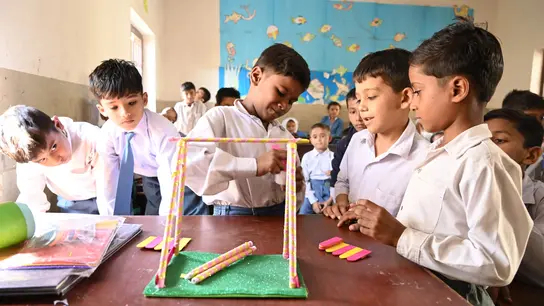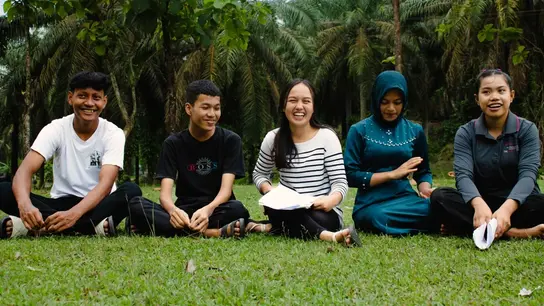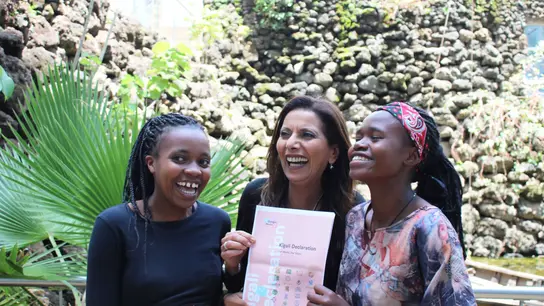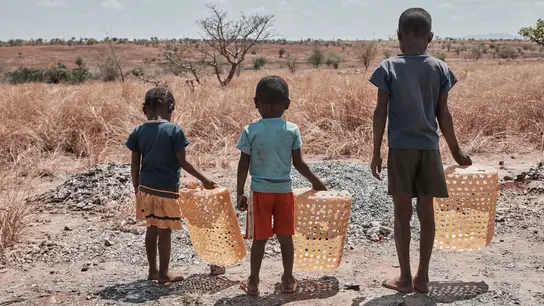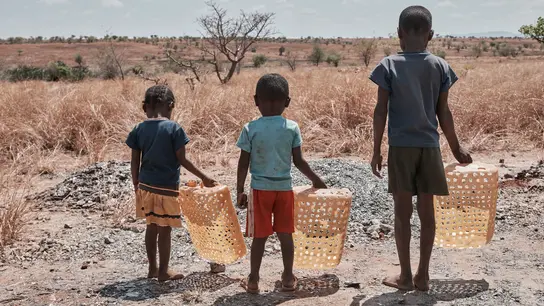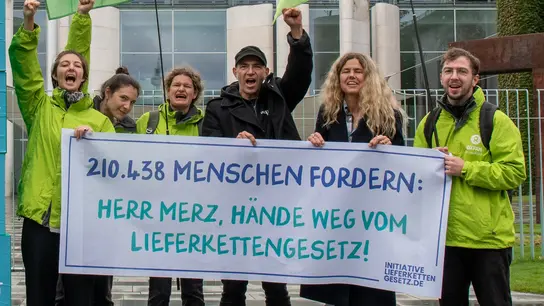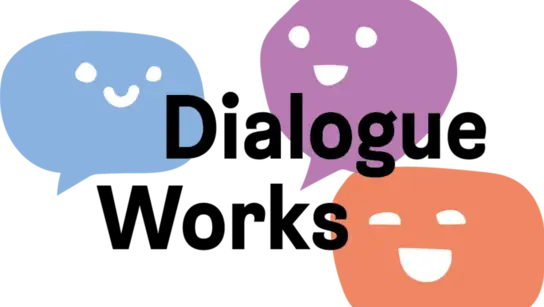138 million girls and boys work worldwide - 8 percent of all children worldwide. 54 million work under conditions that are dangerous and exploitative: they pick cotton, mine gold, mica or iron ore in narrow, unsecured shafts, they piled up in factories twelve hours a day or are exposed to the arbitrariness of the arbitrariness of their employers, often for a hunger wage. There is no time for school and game. Stand up for these children with us!
Your donation helps!
Projects
Reports
Consumption without child labor - tips for consumers
Girls and boys work worldwide and produce products for the world market: exploitative child labor is in food, cosmetics, cars, household appliances or fashion and home textiles. terre des hommes asks them: Wherever possible, use fair trade products or with a reputable social seal. In this way you can help end child labor in supply chains. We give you an overview of what options are available.
Inform nowChild labor - data and facts
End exploitative child labor!
Executive child labor is prohibited worldwide. With the UN sustainability goals, the international community has even decided to end child labor until 2025 worldwide. This period is now running and child labor has not yet been overcome. After an increase in concern in the meantime, however, in recent years it has been possible to return to a way of improvement.
Terre des Hommes helps children escape exploitation, attend school, and receive vocational training. Together with children and our partner organizations, we fight to end exploitative child labor: governments must invest in quality education for children from poor families, increase the legal minimum wage for adults, and monitor employers in high-risk industries.
The United Nations Child Rights Convention stipulates in Article 32: Every child has the right to be protected against economic exploitation. The International Working Organization IAO determines exactly what is common with it:
Exploitial child labor according to the IAO convention 182 from 1999:
- Slavery and bondage and all forms of forced labor
- Work of children under the age of 13
- Children's prostitution and pornography
- Use of children as soldiers
- Illegal activities, such as drug smuggling
- Work that endangers health, security or morality, for example working in quarries, wearing heavy loads or very long working hours and night work.
Work that endangers the health, security or morality of a child is defined in Article 3 of the IAO recommendation 190
- Work that exposes children from physical, mental or sexual abuse
- Work underground, under water, in dangerous heights or tight rooms
- Working with dangerous machines, with equipment or tools, as well as wearing heavy loads
- Working in an unhealthy environment, the children's dangerous substances, excessive temperatures, noise or vibrations
- Work under difficult conditions, such as long working hours, night work or isolated work, in which the child is exposed to the employer.
Further information:
Ilo Convention on Child Labor (IPEC)
The International Labor Organization (IAO) and Unicef presented a report on the situation of child workers in June 2025 in June 2025. According to the IAO, 138 million children work in the age group between five and 17 years.
Among them are 54 million girls and boys in dangerous work:
- They worked in dangerous places such as quarries or commercial plantations, they do night work or have far too long working hours.
- 10.3 million children between five and eleven years work under dangerous conditions.
- They do forced labor, for example in households or in agriculture. They are sold and traded. They are sexually exploited, for example for prostitution or the production of pornography. The international work organization also belongs to slavery and thus to exploitative child labor.
8 percent of all children work worldwide - on average, about thirteen children. Almost every fourth child works in the poorest countries in the world, in war and crisis areas it is even over 20 percent of the children. Here is also one of the reasons from which many children have to work in Africa south of the Sahara: on the African continent there are most fragile states and conflicts, a total of 86.6 million children work in Africa south of the Sahara. North Africa and the Middle East with 12.2 million child workers follow a wide distance, around 8.3 percent of children. In Latin America and Caribbean it is 5.5 percent (7.3 million children), 3.4 percent (17 million children) in Central and South Asia, 3.1 percent (12.3 million children) in East and Southeast Asia.
Is there child labor in Germany?
Minors also work in Germany, with a minimum age of 15 years. Light work on a few hours a week can also perform 13 -year -olds, such as playing newspapers or baby finishes ( JarbSchG - law to protect the working youth ).
Nevertheless, there are repeated cases of child labor in Germany that clearly violate legal standards. This finding was also reached by the Terre des Hommes Child Labor Report 2024, "Child Labor? In Germany?"
Child labor is in many products: cars, cosmetics, cell phones and computers, fashion and home textiles, coffee, chocolate, tea and juices, hazelnuts and chillies. Children often work at the beginning of the supply chain in the promotion or cultivation of raw materials: they mine mica, which is used in cars, cosmetics and electronics. You harvest cotton for the fashion industry. They pick cocoa, coffee or oranges for food companies. Around ten percent of child workers work for goods that are exported to the world markets.
Many are not employed, but work on the side of their parents or self -organized: they sell to middlemen, for example, what they have taken during the day. Or they move on plantations with their parents at harvest time.
Even children who did not work for the world markets mostly work in the family association or self -organized in the so -called informal sector: they guard the cattle in the pastures, work on the field, look after smaller siblings, get water or sell snacks or other little things on the street. 61 percent of children work in agriculture, followed by services (27 percent) and (31.4 million) and industry (13 percent).
Executive child labor damages the physical and mental health of children and takes the chance of education. Child labor is also harmful to all society because it causes poverty. Non-exploitial work can also have positive consequences.
Negative consequences of exploitative child labor:
- Children ruin their health at work: in quarries they breathe in dusts that damage the airways sustainably. On plantations, they are exposed to harmful pesticides that trigger head and abdominal pain and cause cancer in the long term. Children who wear too heavy loads or carry out monotonous movements all day are causing posture damage. Children who work hard are chronically tired and can hardly concentrate.
- Many children even lose their lives: According to the IAO, around 22,000 children and adolescents die in work accidents every year.
- The mental health of children is at risk from difficult work and endless placking. In addition, a lot of violence suffers: they are shouted at, beaten and kicked, food is withheld from them or they are locked up. Again and again children are sexually harassed and raped at work. Children who are completely subject to the will of other people can hardly develop a healthy self -confidence. Girls and boys suffer from fear and feelings of inferiority, do not dare or fall silent. Some children commit suicide.
- 31 percent of working children between the ages of five and 14 do not attend school. If you don't learn anything, you have little chance of better paid work and will have to get through as a day laborer and unskilled workforce. This is how exploitial child labor holds girls and boys and their families in poverty.
- The exploitation of children damages the economy of a country and inhibits development: because of child workers who have no or poor school qualifications, unskilled workers become workers. In order to increase productivity and take more taxes, economies need well -trained workers.
Especially in the illegal economy, individuals or groups are rich: billion -dollar sales are made every year with children's prostitution and child pornography. Children dig in Congo to Coltan, the business is controlled by Warlords, the regulation of mining prevents the regulation. The international IT industry benefits because Coltan is used to manufacture laptops and cell phones.
Positive consequences of non-exploitative child labor:
No child should have to work. But especially in poorer, structurally weak regions, a flat -rate ban does not always help: not every child labor is one of the worst forms, not all children work in dangerous places. If children from twelve years of age work instead about a few hours a day in his parents' company or do easy work, such as the interacting of newspapers, neighborly help or selling food or small things on the street, this can be an important component of a self -determined life. Thanks to your earnings, you can go to school and buy booklets, pens and books or something to eat. For working children, it is often a matter of sharing their time so that they do not neglect the school and still generate enough income.
For these children, combating exploitative forms of child labor and structural poverty is a priority. They need prospects: Terre des Hommes supports working children in these cases, for example, in completing school and organizing themselves so that they can stand up for their interests and avoid slipping into exploitative work.
Material poverty is a cause of exploitative child labor: if adults generate too little income and are not socially secured, the risk that children will have to work increases. Other causes are discrimination, rightlessness and poor education systems. As a result of displacement and flight, war and armed conflicts and the destruction of the livelihoods through environmental degradation and climate change, a consequence is a result.
- Bad education systems: 263 million children do not go to school worldwide - because there is no school near them or the family cannot afford a school. Many more children hardly learn anything at school, because they sit in crowded classes and are taught by poorly trained teachers. In many countries, the beating is still part of everyday life. School fees or costs for booklets, books or internet access exclude children from poor families. Girls or children who belong to minorities are bullied and excluded.
- Hunger wages, lack of social security and no union organization: adults are unemployed or only earn hunger wages. At the same time, there is no social security, such as unemployment benefit, social assistance or health and short-time work allowance: families are then dependent on the cooperation of the children. During the global lockdowns in Corona pandemic, day laborers and workers lost their income from one day to the other worldwide. Millions of school children had to work everywhere to compensate for their parents' loss of earnings. It is unclear whether you can return to school. Because many have lost the connection or have to work through the family. In some industries there is a real demand for child workers: Employers hire children both in the informal and formal sector because they can then pay even lower wages and children do not organize themselves. Many families cannot expect help from government agencies. In many countries, authorities and police are weak or corrupt and benefit from exploitative work themselves.
- Discrimination: In many companies, certain groups are discriminated against and fundamental rights are robbed. Children rarely have a lobby and are not considered too little in many companies. Women and girls are considered inferior. As a result, there is no value to the school attendance of girls, they are considered a workforce without rights and without voice from an early age. Such discrimination also experiences children from poor families, children from refugee families, migrant children, indigenous people or children of other skin color, ethnic or religious belonging.
- War and armed conflicts destroy a country and drive people to escape. Half of the refugees are children worldwide. They often work to improve family income and because they cannot go to school.
- In many areas of the world, climate change to weather extremes: harvesting traps and small farmers can no longer live on their yields. Children often work with or the whole family moves to the nearest city and works there.
Terre des Hommes helps children escape exploitative working conditions and access education and vocational training. To sustainably end exploitative child labor and prevent children from slipping into such working conditions, changes are necessary at many levels: in families, schools, and neighborhoods, in companies and government agencies. Terre des Hommes therefore involves everyone who can improve the situation of children – both locally and internationally: mothers, fathers, siblings, neighbors, teachers and school administrators, employers, retail companies, and consumers. We can all contribute to ensuring that children go to school instead of toiling away.
Above all, the children themselves are important. They have the right to be consulted and to have a say. Terre des Hommes involves both girls and boys and supports them in representing their concerns. For example, in Tamil Nadu, southern India, groups of girls are working together to ensure that they can attend school and are not forced to work in a cotton mill or be married early. To enable them to represent their concerns and draw the attention of politicians and government officials to problems, Terre des Hommes child laborers in 15 countries through the "Dialogue Works" project
Together with children and our partner organizations Terre des Hommes calls for:
- Better education systems: All children have the right to education. 263 million girls and boys cannot go to school worldwide. Governments and the international community have to invest more and more effectively in education. The goal should be to enable children from poor families and discriminated groups to attend school. It takes more schools, more and well -trained teachers. Curricula must be aligned with the reality of the students and teaching methods must be child -friendly. The beating must be abolished. Free school meals, good school libraries, are particularly important, for example. Schools in regions where many children work must address the topic with children and parents and, for example, track when students cancel school. For example, schools that open again after the Lockdowns in Corona pandemic should actively bring their students back.
- Living wages and social security for adults: Terre des Hommes for example, is involved in the Textile Partnership to ensure that employers pay living wages. Workers must earn enough so that no child in the family has to contribute to the work force and everyone can attend school. Social security for adult workers, such as health and unemployment insurance, is also important.
- Fair trade: Local employers and international companies are not allowed to employ children or tolerate them in their supply chains. Terre des Hommes partner projects therefore ensure that labor and trade inspectors take action on site and guarantee that no children are exploited. To ensure that manufacturers and trading companies operate responsibly, children's and human rights organizations developed Fair Trade and social labels back in the 1990s: Today, fairly traded food and sustainable fashion can be bought everywhere. We ask you: Choose goods from Fair Trade or with a reputable label . Encourage your club, the school kiosk, or the canteen at your workplace to switch to products without child labor. Ask your city if there are guidelines for fair procurement so that, for example, the pedestrian zone is not paved with stones obtained by children. We will introduce you to products that may involve child labor and recommend reputable alternatives.
However, the responsibility must not be placed solely on consumers: Therefore, Terre des Hommes together with the Supply Chain Law Initiative, is calling on the German Federal Government and the European Union to oblige companies to respect children's and human rights in their supply chains .
Exploitative child labor is present in food, cosmetics, cars, household appliances, fashion, and home textiles. Terre des Hommes urges you to choose Fair Trade products or those with a reputable social label wherever possible. On our page "Consumption without Child Labor - Tips for Consumers," we provide an overview of Fair Trade products and which labels represent specific product categories.
What you can do
You too can do something to contain child exploitation and support working children. What options are there?
- Consumption without child labor - tips for a fair purchase
on our website "Consumption without child labor - tips for consumers" you will find useful information about fair trade products and the most important seals.
- Binding rules for companies:
Terre des Hommes is committed to obligating companies to comply with fundamental human rights in their supply chains, such as the prohibition of exploitative child labor. We are involved in the Supply Chain Law Initiative .
- Your donation helps in the fight against child labor
support our projects for child workers with your donation . You can help directly on site - even the vast majority of child workers who do not work for export in industrialized countries.
- Campaign »Get started! Together end exploitation “
the action” get started! Together, end exploitation «takes the situation and (injured) rights of working children in view. Young people are active with terre des hommes and work with their own actions that can be carried out all year round for the rights of working children. more...
Information material on child labor
Free information material for ordering and download can be found in our download area.
Browse for materialYour contact person

Katharina Debring
Advocacy speaker

